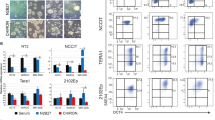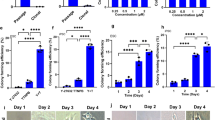Abstract
Differentiation of the human embryonal carcinoma cell line NTERA-2 is characterized by changes in morphology, altered patterns of gene expression, reduced proliferative potential, and a loss of tumorigenicity. The cellular repressor of E1A-stimulated genes, CREG, was previously shown to antagonize transcriptional activation and cellular transformation by the Adenovirus E1A oncoprotein. These properties suggested that CREG may function to inhibit cell growth and/or promote differentiation. Here we show that CREG is a secreted glycoprotein which enhances differentiation of NTERA-2 cells. Northern blot analysis reveals that, although CREG mRNA is widely expressed in adult tissues, CREG mRNA is not significantly expressed in pluripotent mouse embryonic stem cells or NTERA-2 embryonal carcinoma cells. CREG mRNA is rapidly induced upon in vitro differentiation of both mouse embryonic stem cells and human NTERA-2 cells. We show that constitutive expression of CREG in NTERA-2 cells enhances neuronal differentiation upon treatment with retinoic acid. Media enriched in CREG was also found to promote NTERA-2 differentiation in the absence of an inducer such as retinoic acid. These studies suggest that secreted CREG protein participates in a signaling cascade important for differentiation of pluripotent stem cells such as those found in teratocarcinomas.
This is a preview of subscription content, access via your institution
Access options
Subscribe to this journal
Receive 50 print issues and online access
$259.00 per year
only $5.18 per issue
Buy this article
- Purchase on Springer Link
- Instant access to full article PDF
Prices may be subject to local taxes which are calculated during checkout







Similar content being viewed by others
References
Andrews PW . 1984 Dev Biol 103: 285–293
Andrews PW . 1998 Apmis 106: 158–167
Andrews PW, Damjanov I, Berends J, Kumpf S, Zappavigna V, Mavilio F and Sampath K . 1994 Lab Invest 71: 243–251
Andrews PW, Gonczol E, Plotkin SA, Dignazio M and Oosterhuis JW . 1986 Differentiation 31: 119–126
Andrews PW, Nudelman E, Hakomori S and Fenderson BA . 1990 Differentiation 43: 131–138
Baldassarre G, Bianco C, Tortora G, Ruggierro A, Moasser M, Dmitrovsky E, Bianco AR and Ciardiello F . 1996 Int J Cancer 66: 538–543
Baldassarre G, Romano A, Armenante F, Rambaldi M, Paoletti I, Sanomenico C, Pepe S, Staibano S, Salvatore G, De Rosa G, Persico MG and Viglietto G . 1997 Oncogene 15: 927–936
Baselga J, Maerz WJ, Moy D, Miller Jr WH, Castro L, Reuter VE, Yao TJ, Masui H and Dmitrovsky E . 1993 Oncogene 8: 3257–3263
Chomczynski P and Sacchi N . 1987 Anal Biochem 162: 156–159
Dmitrovsky E, Moy D, Miller WH, Li A and Masui H . 1990 Oncogene Res 5: 233–239
Eisenbarth GS, Walsh FS and Nirenberg M . 1979 Proc Nat Acad Sci 76: 4913–4917
Hemmati-Brivanlou A and Melton D . 1997 Cell 88: 13–17
Keller GM . 1995 Curr Opin Cell Biol 7: 862–869
Kurie JM, Brown P, Salk E, Scheinberg D, Birrer M, Deutsch P and Dmitrovsky E . 1993 Differentiation 54: 115–122
Maerz WJ, Baselga J, Reuter VE, Mellado B, Myers ML, Bosl GJ, Spinella MJ and Dmitrovsky E . 1998 Oncogene 17: 761–767
Miller Jr WH, Maerz WJ, Kurie J, Moy D, Basega J, Lucas DA, Grippo JF, Masui H and Dmitrovsky E . 1994 Differentiation 55: 145–152
Miller Jr WH, Moy D, Li A, Grippo JF and Dmitrovsky E . 1990 Oncogene 5: 511–517
Moasser MM, Khoo KS, Maerz WJ, Zelenetz A and Dmitrovsky E . 1996 Differentiation 60: 251–257
Moasser MM, Reuter VE and Dmitrovsky E . 1995 Oncogene 10: 1537–1543
Pleasure SJ and Lee VM . 1993 J Neurosci Res 35: 585–602
Shevinsky LH, Knowles BB, Damjanov I and Solter D . 1982 Cell 30: 697–705
Simeone A, Acampora D, Arcioni L, Andrews PW, Boncinelli E and Mavilio F . 1990 Nature 346: 763–766
Spinella MJ, Kitareewan S, Mellado B, Sekula D, Khoo KS and Dmitrovsky E . 1998 Oncogene 16: 3471–3480
Veal E, Eisenstein M, Tseng ZH and Gill G . 1998 Mol Cell Biol 18: 5032–5041
Wakeman JA, Walsh J and Andrews PW . 1998 Oncogene 17: 179–186
Acknowledgements
We thank Catherine Porcher for help with ES cell growth and differentiation, Sutisak Kitareewan and Ethan Dmitrovsky for advice on FACs analysis of NTERA-2 differentiation, and Domenic Totorella and Hidde Ploegh for help with the microsome experiments. ES cells were a kind gift of Catherine Porcher and Stuart Orkin. Ethan Dmitrovsky and Stuart Orkin provided cDNA probes. We also thank Keith Blackwell, Azad Bonni, Karl Munger and Yang Shi for helpful comments on the manuscript. R Groisman was supported by a postdoctoral fellowship from Association pour le Recherche sur le Cancer. This work was supported by grants from the Jessie B Cox Charitable Trust/The Medical Foundation and the National Institutes of Health to G Gill.
Author information
Authors and Affiliations
Rights and permissions
About this article
Cite this article
Veal, E., Groisman, R., Eisenstein, M. et al. The secreted glycoprotein CREG enhances differentiation of NTERA-2 human embryonal carcinoma cells. Oncogene 19, 2120–2128 (2000). https://doi.org/10.1038/sj.onc.1203529
Received:
Revised:
Accepted:
Published:
Issue Date:
DOI: https://doi.org/10.1038/sj.onc.1203529
Keywords
This article is cited by
-
CREG Protects Retinal Ganglion Cells loss and Retinal Function Impairment Against ischemia-reperfusion Injury in mice via Akt Signaling Pathway
Molecular Neurobiology (2023)
-
The secreted inhibitor of invasive cell growth CREG1 is negatively regulated by cathepsin proteases
Cellular and Molecular Life Sciences (2021)
-
Cellular repressor of E1A stimulated genes enhances endothelial monolayer integrity
Molecular Biology Reports (2013)
-
Gene-expression profiles and transcriptional regulatory pathways that underlie the identity and diversity of mouse tissue macrophages
Nature Immunology (2012)
-
Gene expression changes of interconnected spared cortical neurons 7 days after ischemic infarct of the primary motor cortex in the rat
Molecular and Cellular Biochemistry (2012)



